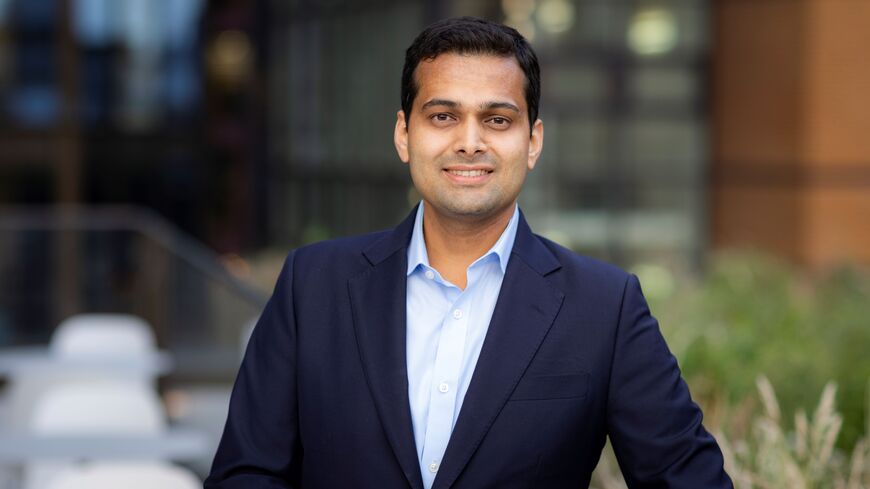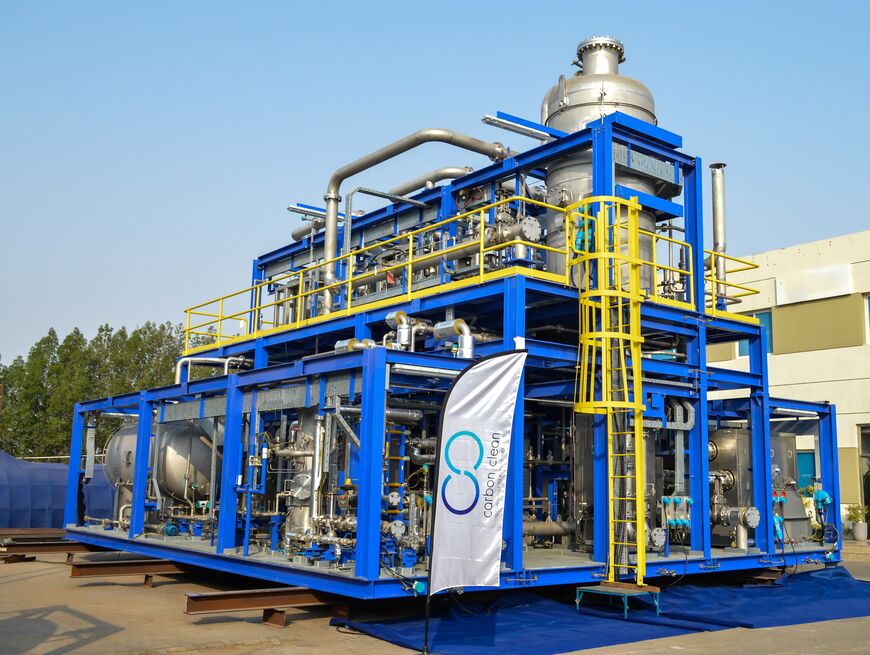The British company’s new project with the UAE energy major is hoping to address those skeptical about the cost, efficacy and viability of carbon dioxide capture as a climate solution.

November 8, 2023
LONDON — Back in 2009, Aniruddha Sharma protested on the streets of Copenhagen as part of the Indian Youth Climate Network against global inaction on climate change at the COP15 conference. His climate activism helped inspire him to establish Carbon Clean, a Britain-based carbon capture, utilization and storage (CCUS) company that same year that originally received funding from the UK and US departments of energy before being financed by the private sector. Since then, the business has grown to have more than 85 active patent assets in more than 30 countries, including Britain, Germany, the United States and India.
The company is also setting up shop in the Middle East. In October, the Abu Dhabi National Oil Company (ADNOC) opted to use Carbon Clean’s “CycloneCC” technology for a carbon dioxide capture project at Fertiglobe’s nitrogen fertilizer plant. Fertiglobe is a joint venture between the state-owned oil company and Korean fuel producer OCI, which runs the plant in the Al Ruways Industrial Complex in Abu Dhabi in the United Arab Emirates. CycloneCC is being piloted industrially this month for the first time.
Speaking to Al-Monitor at Carbon Clean’s London headquarters, Sharma explained that traditionally, CCUS has relied on feeding gas through large absorption and stripping towers, where solvents and heat are used to separate, capture and compress CO2. These techniques have drawn skepticism because they are costly in capital and energy, and the projects typically take years to build. Given how much electricity they need to run, they have not been proven at scale to be much better for the environment than not having them. But unlike these methods, CycloneCC uses technology that allows for prefabricated modular carbon capture units half the size of conventional ones that can be set up in six to eight weeks, Sharma said. Carbon captured by each box depends on CO2 concentration and ranges from 75 to 850 tonnes per day.
The CycloneCC unit is one of several projects Fertiglobe is exploring to reduce emissions and meet the increasing demand for low-carbon hydrogen and ammonia, which can be used to power vehicles and make fertilizers. If the pilot is successful, more units will be deployed across ADNOC and Fertiglobe’s operations.
ADNOC, which pumps almost all of the UAE’s oil, doubled its annual target to 10 million tonnes of CCUS capacity per annum by 2030. However, the company remains one of the world’s biggest polluters. According to projected data from research firm Rystad Energy analyzed by the NGO Global Witness, in 2030 alone, ADNOC aims to produce more than 1.3 billion barrels of oil and nearly 90 billion cubic meters of gas, the report said. In 2021, the UAE produced 171 million tonnes of crude oil and Natural Gas Liquids and nearly 57 billion cubic meters of natural gas.
In 2023, ADNOC is likely to emit 487 million tonnes of CO2, while in 2030 it is projected to emit 684 million tonnes, the Global Witness report said. The company’s CCUS figures are not included in these numbers, the organization told Al-Monitor. That said, the 10 million tonnes a year captured in 2030 is barely a dent in 684 million tonnes of total emissions.
ADNOC has said the analysis is misleading as it makes no distinction between production capacity and actual production. Global Witness disputed the claim and said its analysis focuses on projected production.

Sharma said ADNOC — whose CEO Sultan Al Jaber is controversially presiding over the COP28 UN climate negotiations this year — has ambitious plans to capture carbon dioxide and will present further opportunities for Carbon Clean to build infrastructure in the UAE to help companies implement industrial plans to decarbonize.
“In an industrial plan, you could probably get started with 10% [reduction of CO2 emissions] in 2025, add another 20% in 2027,” he said, adding that by the 2030s, companies will be ready to “add another 30%.”
Sharma explained, “The immediate objective is to demonstrate our technology in the UAE, showing our capabilities and how we can support industrial decarbonisation.”
If successful, it will decarbonize an existing facility from the inside and will allow for CCUS on a mass scale via the deployment of larger CycloneCC units being manufactured in the UAE, across facilities operated by ADNOC companies as well as more widely in the Middle East.
Middle Eastern expertise
The Middle East is one of Carbon Clean’s top markets and several companies in the region have announced “huge plans” to capture CO2 and decarbonize assets, Sharma said. Companies in the energy-rich region have technical expertise and experience with carbon capture, as state-run oil majors ADNOC and Saudi Aramco have been operating facilities for decades. Sharma compared carbon capture to producing oil and gas but “in reverse,” adding that many energy companies could easily add the technology to their facilities.
Like ADNOC, Saudi Aramco is a significant polluter. The nongovernmental organization ClientEarth estimates the oil company to be responsible for 4% of the world’s greenhouse gas emissions since 1965. Although the world’s largest corporate greenhouse gas emitter has pledged to be “operational net zero” by 2050, that promise only applies to Aramco’s industrial sites and excludes the CO2 produced when clients burn their oil.
Aramco says it will reduce emissions across its assets by more than 50 million tonnes per annum of CO2 by 2035, including capturing, utilizing or storing 11 million tonnes per annum by 2035. The company is also working with the Saudi energy minister to capture 9 million tonnes of CO2 per year by 2027, rising to 44 million tonnes of CO2 per year by 2035.
“These are huge volumes if you think about the global carbon capture capacity,” said Sharma. “This is really where my point of scalability comes. The global carbon capture installed capacity today is 44 million tonnes per year of CO2 capture. That’s it.”
The International Energy Agency has said in its latest net-zero report that if the world wants to limit global warming by 1.5 degrees Celcius over pre-industrial levels to meet the Paris goals by 2030, some 759 million tonnes of CO2 must be captured a year, if emissions targets are adhered to. That is more than a 17-fold increase from today’s figure and will require a scale-up similar to that in the solar and wind markets over the last decade, against the backdrop of widespread government support and incentives for businesses in the sector. Sharma said a similar level of political support is required for companies manufacturing or using CCUS technology to make that leap.
“Today over 45 countries have CCUS projects in development. If all announced capture projects are built, around 400 [million tonnes of] CO2 could be captured every year globally by 2030 — more than eight times current capacity,” the IEA report read.
Carbon Clean wants to mass produce CycloneCC boxes on an industrial scale. Around the COP28 UN climate conference or just after, Sharma hopes to share the first data from the pilot on the ADNOC site that will include how much CO2 has been captured and how. At the summit, he wants to communicate that industrial decarbonization will take time and will need standardization and meeting the scale-up goals will require a concerted effort, though European and US policies are “moving in the right direction.”
Just hot air?
An Energy Institute report from June found that fossil fuels make up 82% of the world’s total energy consumption — suggesting that decarbonization on its own will not be enough and a phase-down will be required to meet international climate goals.
Critics of CCUS claim the efficiency of the technology is unproven on a large scale and will be used by major polluters to hide the fact they are still increasing emissions. In response, Sharma agrees that CCUS is not a panacea for reaching net zero, but believes it has a critical role to play. He said he understands why certain civil society organizations are opposing the move and making those accusations, especially given the historical context of fossil fuel companies being opaque about their impact on the climate. But he believes that with climate change being such a huge challenge, you “need all the arrows in your quiver to be able to solve it.”
The speed of a just transition is “unheard of” compared to any other adaptation the world has gone through and not everyone has analyzed all the aspects in detail, he said. Also, hard-to-abate sectors like cement and steel are basic commodities needed to make houses and other critical infrastructure. He noted that 2 billion people on the planet do not have electricity, so their energy ambitions will be different from those in richer countries.
Sharma said much can be done to cut CO2 emissions from hard-to-abate industries. “Zero-carbon cement, zero-carbon steel — it is possible. It’s already happening now,” he said, adding that one of Carbon Clean’s facilities in India is using captured CO2 to make soda ash, which can be used to create zero-carbon glass.
“Those are the kind of things that are actually going to drive this conversation forward and will lead to a much quicker, faster, better action and act as a bridge to other organizations who have skepticism to say actually, this is not about just oil and gas companies, it’s much bigger than that,” Sharma said. “I think industrial carbon capture and decarbonization must be prioritized if we have to make the next leap of the transition.”
